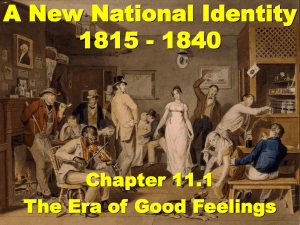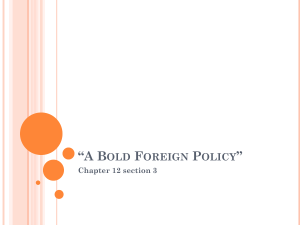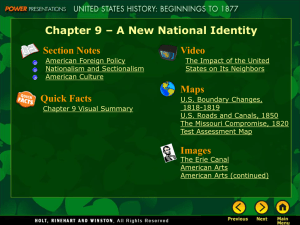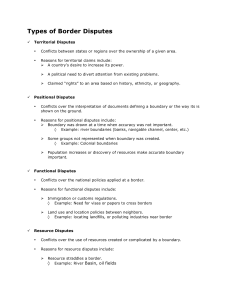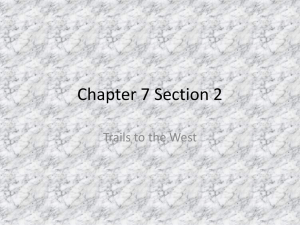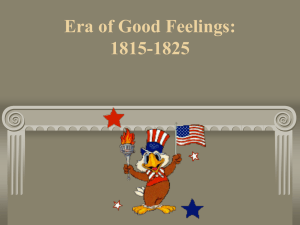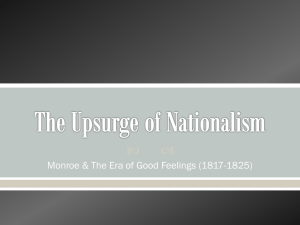Chapter 9 Notes - Bismarck Public Schools
advertisement
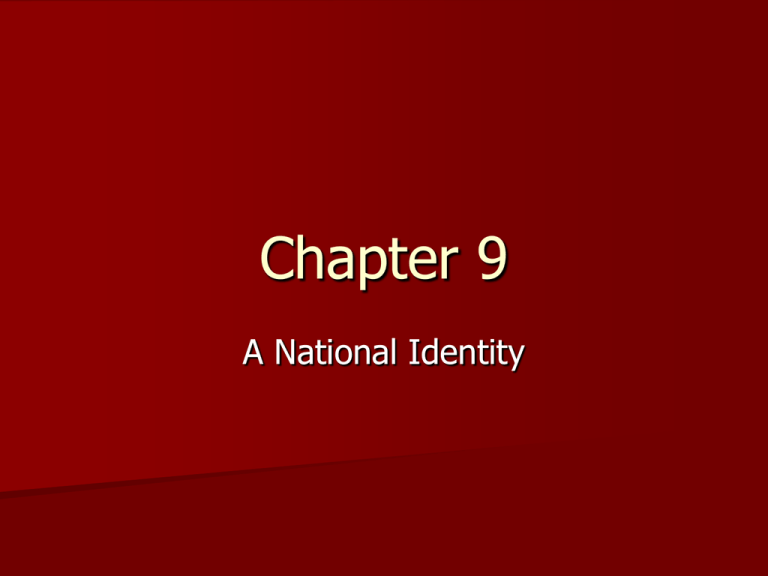
Chapter 9 A National Identity Main Ideas The Big Idea The United States peacefully settled disputes with foreign powers. Main Ideas The United States and Great Britain settled their disputes over boundaries and control of waterways. The United States gained Florida in an agreement with Spain. With the Monroe Doctrine, the United States strengthened its relationship with Latin America. Settling Disputes United States and British Canada both wanted naval and fishing rights on the Great Lakes. – Rush-Bagot Agreement (1817) limited naval power on Great Lakes for both. – Now the two countries could live alongside one another peacefully Settling Disputes Argued over fishing rights off Canada, fur trade in Oregon, and the U.S.–Canadian border – Convention of 1818 allowed U.S. fishing off Canada and set the border between the United States and Canada at the 49th parallel as far west as the Rocky Mountains. – United States and Britain agreed to share Pacific Northwest Taking Florida Conflict with Spain over American settlers near the U.S.–Florida border Secretary of State John Quincy Adams talked with Spain’s Luis de Onís. President James Monroe sent troops to secure the border. There was conflict with the Seminoles over raids of U.S. settlements and runaway slaves. Taking Florida • Andrew Jackson’s captured Seminole raiders, beginning First Seminole War • U.S. military overthrew Spanish governor of Florida. • Spain and United States signed Adams-Onís Treaty in 1819;, and settled all border disputes. • United States received East Florida, gave up claim to Texas, and agreed to pay U.S. citizens’ claims against Spain. The Monroe Doctrine Latin American countries declared independence from Spain. – Simon Bolívar led many of these revolutions. – The United States feared European countries would take control of newly free countries. United States issued Monroe Doctrine. – Warned European powers not to interfere in Americas – Put Latin America in U.S. sphere of influence – Summarized in Four Basic Points (p. 301) U.S. would not interfere in the affaris of European Nations 2. U.S. would recognize and not interfere with European colonies that already existed in North and South America 3. The Western Hemisphere was to be off limits to future colonization by any foreign power 4. The U.S would consider any European power’s attempt to colonize or interfere with nations in the W. hemisphere to be a hostile act. 1. Section 2 Odds N’ Ends Nationalism – Feelings of pride and loyalty to a nation. Erie Canal – Transportation Route from Albany, NY to Buffalo, NY Sectionalism – disagreements between different regions of the country. Missouri Compromise Missouri Compromise – settled the slavery question for free and slave states. Had three conditions: – Missouri would enter as a slave state. – Maine would join as a free state. – Slavery would be prohibited in any new territories north of Missouri’s southern border. American Culture The Big Idea As the United States grew, so did our culture. This gave us a new national identity. Main Ideas American writers created a new style of literature. A new style of art showcased America and its people. American ideals influenced other aspects of culture, including religion and music. Architecture and education were affected by new ideas as well. American Writers Washington Irving – Wrote about American history – Used satire to warn Americans they should learn from the past and be cautious about the future – Combined European influences with American settings and characters American Writers James Fenimore Cooper – Focused on American characters and society – Wrote stories about the western frontier and Native Americans – Popularized historical fiction Architecture American architects built buildings after the style of ancient Greece and Rome. – Admired old civilizations for their democratic and republican ideals Early American political leaders believed an educated populace was needed for democracy. – The idea of state-funded public schools gained support. – Massachusetts was the first state for public education.
